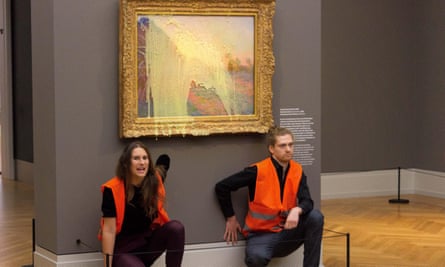Giovanni Aloi argues that climate activists have unknowingly played into the hands of big oil by conducting 38 attacks on art, and suggests it is time to change strategies.
H
Can you recall the number of environmental protests that were held in museums in 2022? How many of the recent ones caused widespread outrage? Did any of these protests result in actual change? The protesters are fighting for a serious cause and the threat is imminent, making their message urgent and crucial. However, it seems like the public may not be fully understanding it.
In the past, Andy Warhol’s Brillo Boxes and repeated Marilyn Monroe screen-prints brought attention to the concept of mindless repetition in modern society. This idea is deeply ingrained in the oversaturated modes of production and consumption that distract and overwhelm, leading to a sense of apathy. How much repetition is too much? Repetition can have a complex impact on experiences, either deepening or hollowing them out depending on how it is used. When something shocking is repeated ad libitum, it quickly becomes mundane. Recognizing this risk, skilled artists strive to constantly reinvent themselves instead of repeating their work. Many modern thinkers, such as Friedrich Nietzsche, Søren Kierkegaard, Jean Baudrillard, Walter Benjamin, Mark Fisher, Frantz Fanon, Robert Hughes, and Amia Srinivasan, have extensively explored the pervasive pacifying effects of unintentional repetition. The initial shock of something new fades quickly.
The activists of Last Generation and Just Stop Oil are urging us to pay attention as they made a statement by splashing tomato soup on Van Gogh’s Sunflowers and throwing mashed potatoes at Monet’s Haystacks. Their goal is to protect us from falling into a state of dull, capitalist-induced indifference that has skewed our priorities. During a recent demonstration, two Riposte Alimentaire protesters posed the question, “Which holds greater significance – art or the right to access healthy, sustainable food?” as they threw pumpkin soup on the Mona Lisa.
However, the well-known demonstrations involving adhesive, pigment, and food tossing are only a small part of the overall problem. These groups of activists regularly participate in truly meaningful efforts, much of which goes unnoticed by the media due to a lack of sensationalism. As they continue to protest, they have become aware of this bias in the media, which has trapped them into seeking attention. As a result, they are now stuck in a never-ending cycle of capitalist-induced apathy, which they originally aimed to free everyone from.
In 2023, a research conducted by Apollo Academic Surveys found that although disruptive strategies may be helpful for certain causes, they often do not result in significant change when the issue is highly recognized but lacks support. The constant barrage of negative comments on social media platforms serves as evidence of how these protests have had a detrimental impact on public opinion. As addressing the climate crisis requires collective action, the gravity of this alienation from the public should not be underestimated. In 2022, a study published by climatologist Michael E Mann revealed that due to the protests, many individuals were less motivated to participate in environmental efforts than they were before.

The demonstrations at the museum have transformed environmental advocates into the ideal targets for oil companies. Is it possible that these activists, who are eager to have their voices heard, are not truly listening to us?
The lack of connection with the general population is due to a disconnect between the location of the protest, the message being conveyed, and the intended recipient. This issue is rooted in historical misunderstandings and a misguided belief in the idealized notion of a heroic savior. Some individuals justify throwing food at paintings by referencing suffragette Mary Richardson’s 1914 act of slashing Velázquez’s Rokeby Venus as evidence that similar tactics are effective. However, art experts have noted that this event had a negative impact on public opinion, and subsequent attacks on museums only served to alienate more people rather than gaining support for the cause. It is difficult to determine the true effectiveness of these tactics in advancing the suffrage movement or if they hindered it. What played a crucial role in the suffragettes’ success was their united effort, with a clear and tangible goal in mind.
After repeatedly witnessing the same trick, the latest attack on the Mona Lisa with pumpkin soup seemed redundant and ineffective. It is now crucial for activist groups to utilize truly impactful strategies, rather than allowing the media to corner them. Successful alternative approaches can be found right in front of the activists. For instance, in 2016, oil protesters put an end to BP’s 26-year-long funding of Tate galleries by organizing a variety of creative and imaginative performances, events, and sit-ins at Tate Modern and Tate Britain. Nan Goldin’s campaign against the Sackler family, a big pharma company, has also yielded impressive results, causing many institutions to sever ties and remove their name from gallery walls.
The success of these demonstrations can be attributed to their specific focus and clear alignment with the goals of the targeted institutions and their ethical issues. These protests serve as educational opportunities without placing blame or confrontation on museum visitors. By applying pressure in strategic areas, they have gained the attention of all parties involved. While some may make grandiose claims about the impact of non-violent protests on works of art, it is clear that environmental activists have primarily used museums as platforms for their message and artworks as tools for amplifying their voices. It is not a coincidence that social media comments often suggest redirecting protests from museums to the headquarters of oil companies. Perhaps it is time for protesters to listen to the perspectives of museum visitors and reconsider their tactics?
Source: theguardian.com


